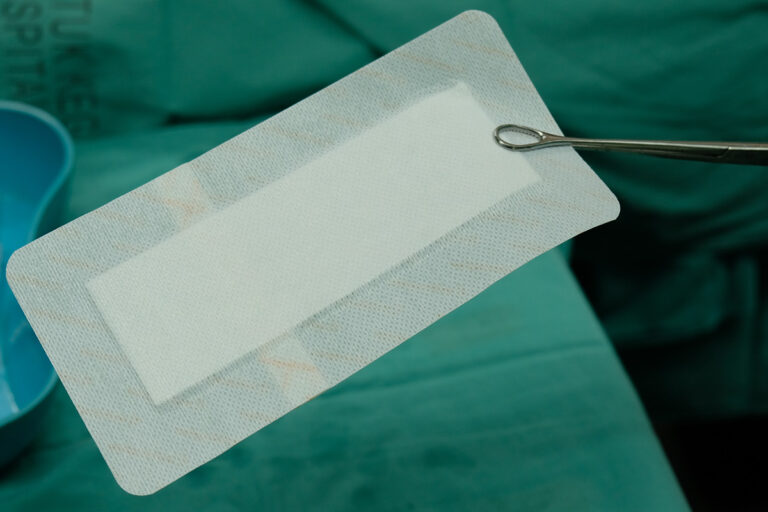Wound Care
Solutions for Wound Care
With our exceptional fabrication capabilities combined with access to medical-grade foams, films, and other specialty materials, Armstrong is able to deliver a diverse range of woundcare solutions. These solutions are designed to treat and safeguard patients’ wounds during the entire healing process.
Primary Dressings
Primary dressings are layers that are in direct contact with the wound bed and provide the first layer of protection and management. They directly interact with the wound and facilitate wound healing.
Materials Available

Non-woven gauzes / meshes
Inexpensive for one-time or short-term use. Highly permeable and relatively non-occlusive. Moderate to excellent absorbency, however lower than foam dressings and may shed fibers or lint. May be impregnated with bio-degradable or non-biodegradable options available.
Cotton
- Good absorbency for managing wound exudate, with a high degree of comfort and softness
- Hypoallergenic, suitable for sensitive skin.
- Generally cost-effective, however lower strength and durability compared to rayon and more likely to shed fibers compared to rayon or polyester
- Biodegradable
Rayon
- Excellent absorbency for managing moderate to heavy exudate.
- Non-linting, minimizing the risk of fiber shedding, however lower strength and durability compared to polyester, however it is biodegradable
- More expensive than polyester
Polyester
- Suitable for applications that require durability and longevity as it less prone to fraying or losing their integrity compared to rayon, however less absorbent compared to rayon or cotton as it is made of non-absorbent fiber
- Durable and resistant to tearing
- Non-linting, minimizing the risk of fiber shedding, however it is non-biodegradable
- More expensive than cotton, and typically blended with rayon or cotton to provide a balance between absorbency, strength and durability
Foams
Thicker and more expensive than non-woven gauze dressings. Highly absorbent and can handle moderate to heavy wound exudate. Absorption capability depends on thickness and composition. May be impregnated or layered in combination with other materials. Available with an adhesive border and/or a transparent film coating that acts as a bacterial barrier. Can be used as secondary dressings when additional absorption is required.
Polyurethane Foam
- Soft, flexible, and highly absorbent, making it effective for managing wounds with moderate to heavy exudate
- Can provide a moist wound environment, cushioning, and protection.
- Comes in different thicknesses and densities to cater to different wound types and exudate levels
Silicone Foam
- Slight lower absorbency compared to Polyurethane foam
- Can provide a moist wound environment, however have slightly different moisture-handling properties
- Typically self-adherent that allow easy removal of dressing without causing damage or discomfort, and can be repositioned without losing their adhesive properties
- Suitable for fragile or sensitive skin and can be used for wounds with moderate to heavy exudate.
- Superior conformability compared Polyurethane foam due to the flexibility and stretchiness of the silicone material, however more expensive
Secondary Dressings
Secondary dressings are layers that are applied on top of the primary dressing and serve additional functions such as providing further protection, absorption, or securing the primary dressing in place. They help to maintain the integrity of the primary dressing and protect it from external elements.
Materials Available

Transparent Films
Thin, breathable, and adhesive dressings that provide a protective barrier over the primary dressing. Allow for visualization of the wound site and help maintain a moist wound environment. Particularly useful for wounds that require frequent monitoring without disturbing the primary dressing. Less absorbent than foams and more suitable for wounds with minimal exudate.
Polyurethane Film
- Typically designed for short to moderate wear times, making them suitable for minor wounds or as secondary dressings over primary wound dressings
- Semi-permeable, to allow oxygen to pass through while maintaining a barrier against bacteria and other contaminants
- Thin and flexible, conforming to the contours of the body, making them suitable for use on joints or areas that require flexibility and movement
Silicone Film
- Often used for chronic wounds or wounds that require longer-term management due to its durability and may have longer wear times compared to some other transparent film dressings
- Gentle self-adhesion with less likelihood to cause damage or pain upon removal, making them suitable for sensitive or fragile skin
- Biocompatible material, and less likely to cause skin irritation or allergies compared to some other materials
- Thin and flexible, conforming to the contours of the body, making them suitable for use on joints or areas that require flexibility and movement
Foams
Highly absorbent and suitable for wounds with moderate to heavy exudate. Effectively manage exudate by absorbing it, reducing the risk of leakage and maceration. Provide cushioning and padding around the wound, offering protection from external pressure, friction, and trauma. Flexible and conform to the body's contours, ensuring a comfortable and snug fit
Polyurethane Foam
- Soft, flexible, and highly absorbent, making it effective for managing wounds with moderate to heavy exudate
- Comes in different thicknesses and densities to cater to different wound types and exudate levels
Silicone Foam
- Suitable for fragile or sensitive skin and can be used for wounds with moderate to heavy exudate, however slight lower absorbency compared to Polyurethane foam
- Typically self-adherent that allow easy removal of dressing without causing damage or discomfort and can be repositioned without losing their adhesive properties
- Superior conformability compared Polyurethane foam due to the flexibility and stretchiness of the silicone material, however it is more expensive
Next-Gen NVHM Solutions for a Smarter, Safer & Greener Future
At Armstrong, we understand the changes and challenges of the Noise, Vibration, Heat & Safety landscape of today’s world, and we’re committed to provide solutions to meet this growing critical need. We’re passionate about what we do and are dedicated to help make the world a more pleasant place to live in.
Receive an accurate quote within 3-5 days when you fill out this form. Or, give us a call: +65 6804 9623

